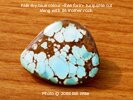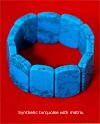 Natural turquoise gemstone is one of the most widely known gems in the world. The popularity of this opaque gem proves that the parameter of beauty in a gemstone need not be limited to its clarity and transparency.
Natural turquoise gemstone is one of the most widely known gems in the world. The popularity of this opaque gem proves that the parameter of beauty in a gemstone need not be limited to its clarity and transparency.
The name turquoise came into use only in the 13th century, when a French trader bought this gem from a Turkish market. He called it ?Pierre Turquoise? meaning Turkish stone. In 5000 B.C. this gemstone was first found in the form of beads in native Mesopotamia (Iraq). In the Indian market the gem is also know as the ?Phiroza?. It is also called as the December Birthstone.
 Known to man almost since the start of the human civilization, turquoise gemstone is very much in fashion even today. Turquoise beads and turquoise wheel beads were stringed together to make necklaces. The Egyptian pharaohs used turquoise jewelry more than 5500 years ago. Chinese artisans carved ceremonial figurines out of this gem almost 3000 years ago. The blue gem turquoise was an accepted source of wealth in North American civilization long before Columbus arrived.
Known to man almost since the start of the human civilization, turquoise gemstone is very much in fashion even today. Turquoise beads and turquoise wheel beads were stringed together to make necklaces. The Egyptian pharaohs used turquoise jewelry more than 5500 years ago. Chinese artisans carved ceremonial figurines out of this gem almost 3000 years ago. The blue gem turquoise was an accepted source of wealth in North American civilization long before Columbus arrived.
 The Persians believed that if a person saw a full moon reflection on a natural turquoise gemstone, he would have good luck and be protected from evil. In some civilization natural turquoise was thrown in a river while praying to the rain gods to appease them in order to get good rains. It was also believed that the gemstone loses it color due to the gems sympathetic behavior towards its wearer?s moods. Good turquoise care therefore is required for maintaining the beauty of the stone.
The Persians believed that if a person saw a full moon reflection on a natural turquoise gemstone, he would have good luck and be protected from evil. In some civilization natural turquoise was thrown in a river while praying to the rain gods to appease them in order to get good rains. It was also believed that the gemstone loses it color due to the gems sympathetic behavior towards its wearer?s moods. Good turquoise care therefore is required for maintaining the beauty of the stone.
 The chemical composition of turquoise gemstone is hydrous phosphate of aluminum and copper with some iron (Cu Al6 (PO4)4 (OH)8 5H2O). Its specific gravity falls between 2.60 and 2.85 and the refractive index ranges between 1.610 and 1.650. The gemstones hardness on Mohs scale is 5.5 to 6.
The chemical composition of turquoise gemstone is hydrous phosphate of aluminum and copper with some iron (Cu Al6 (PO4)4 (OH)8 5H2O). Its specific gravity falls between 2.60 and 2.85 and the refractive index ranges between 1.610 and 1.650. The gemstones hardness on Mohs scale is 5.5 to 6.
Turquoise Color
 Turquoise is found in various shades of blue - blue to blue-green range of colors. The most beautiful and attractive turquoise color is said to be the ?robin?s-egg-blue? or ?sky-blue?. Since gems with the best blue color were mined in Iran (former Persia), the color is also described as ?Persian Blue?.
Turquoise is found in various shades of blue - blue to blue-green range of colors. The most beautiful and attractive turquoise color is said to be the ?robin?s-egg-blue? or ?sky-blue?. Since gems with the best blue color were mined in Iran (former Persia), the color is also described as ?Persian Blue?.
Turquoise from other locations may not be of a very fine blue color. However, light blue, greenish blue, bluish green and yellowish green stones are also commonly used. Turquoise gemstone owes its blue and green color to the trace elements copper and iron, respectively. The stability of the color of this gemstone is directly related to its porosity. This gemstone can decolorize fast and become pale if the porosity is high.
Texture
 The texture of turquoise gemstone is due to its crystal formation and structure i.e. a collection of small crystals grown together as a mass or rock. This makes the gem very porous. Porosity affects the texture and durability of the gem and makes it more prone to absorb impurities.
The texture of turquoise gemstone is due to its crystal formation and structure i.e. a collection of small crystals grown together as a mass or rock. This makes the gem very porous. Porosity affects the texture and durability of the gem and makes it more prone to absorb impurities.
Matrix
 Turquoise is found in limonite and sandstone deposits. The mother rock or matrix in which turquoise is found can often be seen as splotches or a network of brown or black veins running through the stone in a netted pattern. The limonite matrix creates dark brown markings, while the sandstone matrix creates tan markings.
Turquoise is found in limonite and sandstone deposits. The mother rock or matrix in which turquoise is found can often be seen as splotches or a network of brown or black veins running through the stone in a netted pattern. The limonite matrix creates dark brown markings, while the sandstone matrix creates tan markings.
 Many a times it is not possible to fashion the gem without its matrix. In general, the presence of matrix reduces the value of the gem, however the ?spiderweb matrix? (an attractive brown or black limonite veining) may increase the gem?s value if the result is complimentary.
Many a times it is not possible to fashion the gem without its matrix. In general, the presence of matrix reduces the value of the gem, however the ?spiderweb matrix? (an attractive brown or black limonite veining) may increase the gem?s value if the result is complimentary.
 The porosity, texture, evenness of the color and the color itself are the main factors that decide the value of the turquoise gemstone, with evenness of color being more important than the shade of color. Generally bluish turquoise stones are higher in value than greenish ones.
The porosity, texture, evenness of the color and the color itself are the main factors that decide the value of the turquoise gemstone, with evenness of color being more important than the shade of color. Generally bluish turquoise stones are higher in value than greenish ones.
A turquoise which is low in porosity and of fine texture (this also increases the durability of the gemstone) will fetch the highest prices. While a gem with no ?matrix? will command a high price, a gem with ?spiderweb matrix? may also fetch a good price in the market. Treated turquoises are cheaper as compared to the natural untreated turquoise.
 The price of turquoise gemsotne may vary from $3 per carat to $30 per carat depending on its size and quality. A 18x13 mm size cabochon cut turquoise may even sell up to a price of $100. Many treatments are carried out on this gemstone today hence it would be advisable to get it certified from a reputed laboratory before purchase.
The price of turquoise gemsotne may vary from $3 per carat to $30 per carat depending on its size and quality. A 18x13 mm size cabochon cut turquoise may even sell up to a price of $100. Many treatments are carried out on this gemstone today hence it would be advisable to get it certified from a reputed laboratory before purchase.
In ancient times top quality turquoise mining was mainly done in Nishapur, a district of Iran (Persia). However, today China is the major source of top quality turquoise in the world. There are a few new turquoise mines in Iran today that do produce the gem. Other than these mines, turquoises are mined in Tibet, Egypt, Chile and USA. Turquoise is often recovered as a byproduct of large-scale copper mining operations, especially in the United States.
Dying is not a very popular treatment as the gem tends to decolorize and begins to look unnatural over a period of time. In the 1980s, a method of treating turquoise gemstone called ?Zachery? was found. Besides enhancing the color, this treatment makes the gem more stable and also helps in retaining the color of the gem over time.
 Turquoise, besides being the first gem stone to be mined, is also the first gem to be imitated. Gilson (a company that produces synthetic gemstones) made synthetic turquoise for the first time in the1980?s. However, synthetic turquoise gem stone is not very popular and is not seen in the market often.
Turquoise, besides being the first gem stone to be mined, is also the first gem to be imitated. Gilson (a company that produces synthetic gemstones) made synthetic turquoise for the first time in the1980?s. However, synthetic turquoise gem stone is not very popular and is not seen in the market often.
The other imitation is the ?Reconstructed Turquoise?. The name is misleading as it does not have any turquoise in it but is made from a mixture of powdered minerals and dye bonded with plastic or epoxy resin.
Home | Add URL | About Us | Contact Us | Links | Privacy Policy | Resources | Sitemap | Design by Paper Tree
Copyright 2007 GehnaBazaar.com. All rights reserved. The information contained in this webpage may not be published, broadcast, rewritten or redistributed without a prior written consent. Natural Gemstones | Precious Gemstones | Jewellery Designers | Jewelry Institutes | Jewelery Design Institutes | Gemstone Information | Diamond Information | Gemmological Laboratories | Gem Labs | Jewelry Articles | Gold Price | Jewel Store | Buy and Sell Jewellery | Jewery Classes | Deisgn classes | Gemologists | Diamond Price